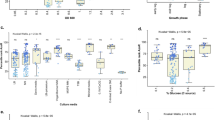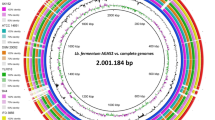Abstract
Quorum sensing is a system of stimuli and response correlated to population density and involves in pathogen infection, colonization, and pathogenesis. Quorum quenching enzymes as quorum sensing inhibitors have been identified in a number of bacteria and been used to control by triggering the pathogenic phenotype. The marine bacteria of Pseudoalteromonas had wide activity of degrading AHLs as a type of signal molecule associated with quorum sensing. We screened many Pseudoalteromonas strains in large scale to explore genes of quorum quenching enzymes from the China seas by whole-genome sequencing rather than genomic library construction. Nine target strains were obtained and an acylases gene APTM01 from the strain MQS005 belonging to PvdQ type on sub-branch in phylogenetic tree. And the heterogenous host containing the vector with target gene could degrade C10-HSL, C12-HSL and OC12-HSL. The obtained AHL acylase gene would be a candidate quorum quenching gene to apply in some fields. We identified that the strains of Pseudoalteromonas have wide AHL-degrading ability depending on quorum quenching. The strains would be a resource to explore new quorum quenching enzymes.





Similar content being viewed by others
References
Jayaraman A, Wood TK (2008) Bacterial quorum sensing: signals, circuits, and implications for biofilms and disease. Annu Rev Biomed Eng 10:145–167. https://doi.org/10.1146/annurev.bioeng.10.061807.160536
Fuqua C, Greenberg EP (2002) Listening in on bacteria: acyl-homoserine lactone signalling. Nat Rev Mol Cell Biol 3:685–695. https://doi.org/10.1038/nrm907
Taga ME, Bassler BL (2003) Chemical communication among bacteria. Proc Natl Acad Sci USA 100(Suppl):14549–14554. https://doi.org/10.1073/pnas.1934514100
Chapalain A, Vial L, Laprade N et al (2013) Identification of quorum sensing-controlled genes in Burkholderia ambifaria. Microbiologyopen 2:226–242. https://doi.org/10.1002/mbo3.67
Whiteley M, Lee KM, Greenberg EP (1999) Identification of genes controlled by quorum sensing in Pseudomonas aeruginosa. Proc Natl Acad Sci USA 96:13904–13909. https://doi.org/10.1073/pnas.96.24.13904
Schuster M (2011) Global expression analysis of quorum-sensing controlled genes. Methods Mol Biol 692:173–187. https://doi.org/10.1007/978-1-60761-971-0_13
Jimenez JC, Federle MJ (2014) Quorum sensing in group A Streptococcus. Front Cell Infect Microbiol 4:127. https://doi.org/10.3389/fcimb.2014.00127
Case RJ, Labbate M, Kjelleberg S (2008) AHL-driven quorum-sensing circuits: their frequency and function among the Proteobacteria. ISME J 2:345–349. https://doi.org/10.1038/ismej.2008.13
Smith R (2003) P. aeruginosa quorum-sensing systems and virulence. Curr Opin Microbiol 6:56–60. https://doi.org/10.1016/s1369-5274(03)00008-0
Devescovi G, Bigirimana J, Degrassi G et al (2007) Involvement of a quorum-sensing-regulated lipase secreted by a clinical isolate of Burkholderia glumae in severe disease symptoms in rice. Appl Environ Microbiol 73:4950–4958. https://doi.org/10.1128/AEM.00105-07
Hentzer M, Wu H, Andersen JB et al (2003) Attenuation of Pseudomonas aeruginosa virulence by quorum sensing inhibitors. EMBO J 22:3803–3815. https://doi.org/10.1093/emboj/cdg366
Wang WZ, Morohoshi T, Ikenoya M et al (2010) AiiM, a novel class of N-acylhomoserine lactonase from the leaf-associated bacterium Microbacterium testaceum. Appl Environ Microbiol 76:2524–2530. https://doi.org/10.1128/AEM.02738-09
Huang JJ, Han JI, Zhang LH, Leadbetter JR (2003) Utilization of acyl-homoserine lactone quorum signals for growth by a soil pseudomonad and Pseudomonas aeruginosa PAO1. Appl Environ Microbiol 69:5941–5949. https://doi.org/10.1128/Aem.69.10.5941-5949.2003
Czajkowski R, Jafra S (2009) Quenching of acyl-homoserine lactone-dependent quorum sensing by enzymatic disruption of signal molecules. Acta Biochim Pol 56:1–16
Chen F, Gao Y, Chen X et al (2013) Quorum quenching enzymes and their application in degrading signal molecules to block quorum sensing-dependent infection. Int J Mol Sci 14:17477–17500. https://doi.org/10.3390/ijms140917477
Estin ML, Stoltz DA, Zabner J (2010) Paraoxonase 1, quorum sensing, and P. aeruginosa infection: a novel model. Adv Exp Med Biol 660:183–193. https://doi.org/10.1007/978-1-60761-350-3_17
Dong YH, Xu JL, Li XZ, Zhang LH (2000) AiiA, an enzyme that inactivates the acylhomoserine lactone quorum-sensing signal and attenuates the virulence of Erwinia carotovora. Proc Natl Acad Sci USA 97:3526–3531. https://doi.org/10.1073/pnas.060023897
Pirhonen M, Flego D, Heikinheimo R, Palva ET (1993) A small diffusible signal molecule is responsible for the global control of virulence and exoenzyme production in the plant pathogen Erwinia carotovora. EMBO J 12:2467–2476
Von Bodman SB, Bauer WD, Coplin DL (2003) Quorum sensing in plant-pathogenic bacteria. Annu Rev Phytopathol 41:455–482. https://doi.org/10.1146/annurev.phyto.41.052002.095652
Dong YH, Gusti AR, Zhang Q et al (2002) Identification of quorum-quenching N-acyl homoserine lactonases from Bacillus species. Appl Environ Microbiol 68:1754–1759. https://doi.org/10.1128/AEM.68.4.1754-1759.2002
Wang WZ, Morohoshi T, Someya N, Ikeda T (2012) AidC, a novel N-acylhomoserine lactonase from the potato root-associated cytophaga-flavobacteria-bacteroides (CFB) group bacterium Chryseobacterium sp. strain StRB126. Appl Environ Microbiol 78:7985–7992. https://doi.org/10.1128/AEM.02188-12
Park SY, Lee SJ, Oh TK et al (2003) AhlD, an N-acylhomoserine lactonase in Arthrobacter sp., and predicted homologues in other bacteria. Microbiology 149:1541–1550. https://doi.org/10.1099/mic.0.26269-0
Khan SR, Farrand SK (2009) The BlcC (AttM) lactonase of Agrobacterium tumefaciens does not quench the quorum-sensing system that regulates Ti plasmid conjugative transfer. J Bacteriol 191:1320–1329. https://doi.org/10.1128/JB.01304-08
Riaz K, Elmerich C, Raffoux A et al (2008) Metagenomics revealed a quorum quenching lactonase QlcA from yet unculturable soil bacteria. Commun Agric Appl Biol Sci 73:3–6
Huang JJ, Petersen A, Whiteley M, Leadbetter JR (2006) Identification of QuiP, the product of gene PA1032, as the second acyl-homoserine lactone acylase of Pseudomonas aeruginosa PAO1. Appl Environ Microbiol 72:1190–1197. https://doi.org/10.1128/AEM.72.2.1190-1197.2006
Zhang X, Enomoto K (2011) Characterization of a gene cluster and its putative promoter region for violacein biosynthesis in Pseudoalteromonas sp. 520P1. Appl Microbiol Biotechnol 90:1963–1971. https://doi.org/10.1007/s00253-011-3203-9
Wang Y, Ikawa A, Okaue S et al (2008) Quorum sensing signaling molecules involved in the production of violacein by Pseudoalteromonas. Biosci Biotechnol Biochem 72:1958–1961. https://doi.org/10.1271/bbb.80090
Dheilly A, Soum-Soutera E, Klein GL et al (2010) Antibiofilm activity of the marine bacterium Pseudoalteromonas sp. strain 3J6. Appl Environ Microbiol 76:3452–3461. https://doi.org/10.1128/AEM.02632-09
Papa R, Parrilli E, Sannino F et al (2013) Anti-biofilm activity of the Antarctic marine bacterium Pseudoalteromonas haloplanktis TAC125. Res Microbiol 164:450–456. https://doi.org/10.1016/j.resmic.2013.01.010
Guo X, Zheng L, Zhou W et al (2011) A case study on chemical defense based on quorum sensing: antibacterial activity of sponge-associated bacterium Pseudoalteromonas sp. NJ6-3-1 induced by quorum sensing mechanisms. Annu Microbiol 61:247–255. https://doi.org/10.1007/s13213-010-0129-x
Fineran PC, Slater H, Everson L et al (2005) Bioactivity and phylogeny of the marine bacterial genus Pseudoalteromonas. PhD thesis, Division of Industrial Food Research. National Food Institute (DTU Food), Technical University of Denmark. https://doi.org/10.1111/j.1365-2958.2005.04660.x
Li R, Zhu H, Ruan J et al (2010) De novo assembly of human genomes with massively parallel short read sequencing. Genome Res 20:265–272. https://doi.org/10.1101/gr.097261.109
Li R, Li Y, Kristiansen K, Wang J (2008) SOAP: short oligonucleotide alignment program. Bioinformatics 24:713–714. https://doi.org/10.1093/bioinformatics/btn025
Besemer J, Lomsadze A, Borodovsky M (2001) GeneMarkS: a self-training method for prediction of gene starts in microbial genomes. Implications for finding sequence motifs in regulatory regions. Nucleic Acids Res 29:2607–2618
Altschul SF, Gish W, Miller W et al (1990) Basic local alignment search tool. J Mol Biol 215:403–410. https://doi.org/10.1016/S0022-2836(05)80360-2
Kanehisa M, Goto S, Kawashima S et al (2004) The KEGG resource for deciphering the genome. Nucleic Acids Res 32:D277–D280. https://doi.org/10.1093/nar/gkh063
Tatusov RL, Fedorova ND, Jackson JD et al (2003) The COG database: an updated version includes eukaryotes. BMC Bioinform 4:41. https://doi.org/10.1186/1471-2105-4-41
Ashburner M, Ball CA, Blake JA et al (2000) Gene ontology: tool for the unification of biology. Nat Genet 25:25–29. https://doi.org/10.1038/75556
Darling ACE, Mau B, Blattner FR, Perna NT (2004) Mauve: multiple alignment of conserved genomic sequence with rearrangements. Genome Res 14:1394–1403. https://doi.org/10.1101/gr.2289704
Lee RD, Jospin G, Lang JM et al (2015) Draft genome sequence of Pseudoalteromonas tetraodonis strain UCD-SED8 (phylum gammaproteobacteria). Genome Announc 3:e01276-15. https://doi.org/10.1128/genomeA.01276-15
Thompson JD, Gibson TJ, Higgins DG (2002) Multiple sequence alignment using ClustalW and ClustalX. Curr Protoc Bioinform. https://doi.org/10.1002/0471250953.bi0203s00
Nicholas KBKBBKB, Jr HBN, Ii DWD et al (1997) GeneDoc: analysis and visualization of genetic variation. EMBnet News 4:14
Sio CF, Otten LG, Cool RH et al (2006) Quorum quenching by an N-acyl-homoserine lactone acylase from Pseudomonas aeruginosa PAO1. Infect Immun. https://doi.org/10.1128/iai.74.3.1673-1682.2006
Lamont IL, Martin LW (2003) Identification and characterization of novel pyoverdine synthesis genes in Pseudomonas aeruginosa. Microbiology. https://doi.org/10.1099/mic.0.26085-0
Solovyev V, Salamov A (2011) Automatic annotation of microbial genomes and metagenomic sequences. In: Li RW (ed) Metagenomics and its applications in agriculture, biomedicine and environmental studies. Nova Biomedical, New Delhi, pp 61–78
Huang Y, Wang J, Luan S (2012) Research status and trends in limnology journals: a bibliometric analysis based on SCI database. Scientometrics 92:735–746
Mei G-Y, Yan X-X, Turak A et al (2010) AidH, an alpha/beta-hydrolase fold family member from an Ochrobactrum sp. strain, is a novel N-acylhomoserine lactonase. Appl Environ Microbiol 76:4933–4942. https://doi.org/10.1128/AEM.00477-10
Mayer C, Romero M, Muras A, Otero A (2015) Aii20 J, a wide-spectrum thermostable N-acylhomoserine lactonase from the marine bacterium Tenacibaculum sp. 20 J, can quench AHL-mediated acid resistance in Escherichia coli. Appl Microbiol Biotechnol 99:9523–9539. https://doi.org/10.1007/s00253-015-6741-8
Ochiai S, Yasumoto S, Morohoshi T, Ikeda T (2014) AmiE, a novel N-acylhomoserine lactone acylase belonging to the amidase family, from the activated-sludge isolate Acinetobacter sp. strain Ooi24. Appl Environ Microbiol 80:6919–6925. https://doi.org/10.1128/AEM.02190-14
Nusrat H, Shankar P, Kushwah J et al (2011) Diversity and polymorphism in AHL-lactonase gene (aiiA) of Bacillus. J Microbiol Biotechnol 21:1001–1011. https://doi.org/10.4014/jmb.1105.05056
Acknowledgements
This work was supported by Guangdong Science and Technology Department (2013B030800001), Shenzhen Science and Technology Project (Grant Nos. JCYJ20140509174140691 and JCYJ20140417113430641), and CAS Adjunct Professorship (2013T1G0038, GJHS2014090100463583).
Author information
Authors and Affiliations
Corresponding author
Ethics declarations
Conflict of interest
We declare that we do not have any commercial or associative interest that represents a conflict of interest in connection with the work submitted.
Additional information
Publisher's Note
Springer Nature remains neutral with regard to jurisdictional claims in published maps and institutional affiliations.
Electronic supplementary material
Below is the link to the electronic supplementary material.
Rights and permissions
About this article
Cite this article
Pan, Y., Wang, Y., Yan, X. et al. Quorum Quenching Enzyme APTM01, an Acylhomoserine-Lactone Acylase from Marine Bacterium of Pseudoalteromonas tetraodonis Strain MQS005. Curr Microbiol 76, 1387–1397 (2019). https://doi.org/10.1007/s00284-019-01739-z
Received:
Accepted:
Published:
Issue Date:
DOI: https://doi.org/10.1007/s00284-019-01739-z




